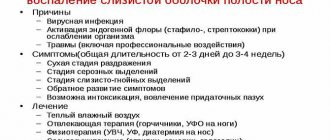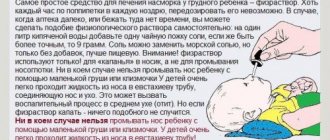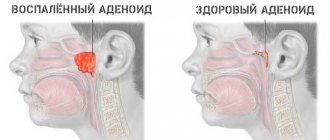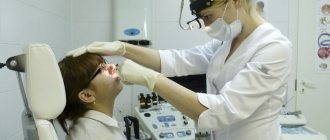- Symptoms of acute rhinitis
- Types and causes of rhinitis
- Diagnostics
- Complications
- Treatment of rhinitis
- Prevention of rhinitis
- Treatment of rhinitis at NIKIO named after. L.I. Sverzhevsky
Rhinitis - inflammation of the nasal mucosa - is one of the most common otolaryngological diseases that almost every person encounters during their life.
Unfortunately, nasal discharge, problems with nasal breathing, and headaches that accompany this disease are rarely a reason to see a doctor. It’s easy to explain: a runny nose is considered a “safe” disease that does not require special treatment. But the variety of forms of rhinitis and the number of complications it can lead to require getting rid of misconceptions: an unattended runny nose can provoke a number of serious medical problems.
Therefore, treating rhinitis is a task that requires a comprehensive solution and high professionalism of a doctor, and home remedies to get rid of a runny nose should be used only after consultation with a specialist.
Symptoms of acute rhinitis
As an independent disease, acute rhinitis is manifested by the following symptoms:
- feeling of itching in the nasal cavity, dryness, frequent bouts of sneezing;
- transparent mucous discharge at the beginning of the disease, and thick, stained with pus or traces of blood - as the pathological process develops;
- nasal congestion, more or less pronounced - from minor difficulties with breathing through the nose to the complete absence of nasal breathing.
Body temperature rarely rises above 37.5-37.7°C, but a headache and a feeling of general “woundness” may be present. Unfortunately, rhinitis is often accompanied by ARVI, influenza, which makes its symptoms blurry and unclear and makes the patient believe that a runny nose is nothing more than an unpleasant sign of the underlying disease and rhinitis is not treated. With allergic rhinitis, there is no increase in temperature, but instead other signs of respiratory allergies may be present - redness and swelling of the conjunctival area, lacrimation.
Very often, the weakening of the symptoms of acute rhinitis is misleading, causing the patient to believe that the disease has gone away on its own. But it is at this moment that maximum attention should be shown, since a decrease in the intensity of the runny nose may not mean recovery, but the transition of the disease to a chronic form. Therefore, be sure to consult a doctor if, against the background of general well-being, there is periodic nasal congestion, accumulation of thick mucus or dry crusts in the nasal passages, reduced acuity of smell and taste, or if you often feel an unpleasant odor that no one else can hear except you.
Classification of rhinitis in children
Depending on the cause of development, rhinitis can be allergic or non-allergic.
Allergic rhinitis is characterized by the absence of inflammation of the nasal mucosa and is treated in the same way as any other allergic disease.
Non-allergic rhinitis in children and adults is divided into types depending on the nature of the course: acute, subacute and chronic processes are distinguished. In turn, the chronic form of the disease can be simple (catarrhal, hypertrophic, atrophic, vasomotor or mixed).
Symptoms of acute rhinitis in children
Acute rhinitis in children has several stages, each of which is characterized by its own symptoms:
- stage of irritation: the child experiences nasal congestion and severe difficulty in nasal breathing;
- serous stage: characterized by copious clear discharge from the nasal passages, sneezing, lacrimation;
- stage of mucopurulent discharge: the discharge thickens, becomes purulent in nature, and its volume gradually decreases.
When a child develops posterior rhinitis, the symptoms may be less pronounced, since the discharge flows mainly down the back wall of the pharynx.
In addition to the typical problems associated with inflammation of the nasal mucosa, the child may experience:
- weakness;
- headache;
- insomnia;
- fatigue;
- deterioration in odor perception;
- constant feeling of mucus in the throat;
- memory problems.
Symptoms of chronic rhinitis in children
Signs of chronic rhinitis in children are usually less pronounced than in the acute course of the disease. The child may complain about:
- periodic nasal congestion on one side or the other;
- light mucous or mucopurulent discharge;
- cough that gets worse in a horizontal position and is associated with mucus draining down the back of the throat;
- decreased sense of smell;
- nasal and hoarse voice;
- fatigue, decreased performance, periodic headaches, etc.
Types and causes of rhinitis
Rhinitis in adults and children is classified according to several criteria.
With the flow:
- Acute rhinitis is a disease that occurs suddenly and is accompanied by pronounced, increasing symptoms.
- Chronic rhinitis is the most common complication of the previous form, when treatment of acute rhinitis was not carried out. In this case, the disease exists in the “background” - with an almost asymptomatic course, and is manifested by nasal discharge and other signs against the background of decreased immunity or irritation of the mucous membrane of the cavity. Some of the common types of chronic rhinitis are vasomotor (impaired neurovascular regulation of processes in the mucosa), atrophic (thinning of the mucosa and loss of its functions) and hypertrophic (excessive thickening of the mucosa).
For development reasons:
- Infectious. This type of runny nose is predominant in the practice of otolaryngologists. With infectious rhinitis, the nasal mucosa is affected by viruses, which quickly spread to the entire nasopharynx. In the presence of predisposing factors, secondary bacterial infections are often associated with viral rhinitis - the nasal mucosa, weakened by viruses, is unable to resist pathogenic bacteria that penetrate it with inhaled air.
- Allergic. The second most common type of rhinitis, which develops when allergens come into contact with the nasal mucosa. In this case, the inflammatory process occurs under the influence of histamines, substances whose production is stimulated by the immune system in response to the allergen.
- Traumatic. In this case, inflammation of the mucous membrane develops after it is damaged as a result of surgery, trauma to the nose and face, entry of a foreign body into the nasal passages, etc.
- Non-infectious. This type of rhinitis refers to a large group of nasal breathing disorders caused by regular inhalation of dust, inappropriate use of a number of medications, etc.
Symptoms of rhinitis
The course of acute rhinitis is characterized by the following main symptoms:
- runny nose;
- itching in the nasal cavity;
- nasal congestion;
- loss of smell;
- sneezing, coughing.
They are often accompanied by other symptoms: malfunction of the cardiovascular system and cerebral circulation. The child develops red eyes, headache, and insomnia. Loss of appetite and lethargy can also be symptoms of acute rhinitis.
Diagnostics
Symptoms and treatment of rhinitis are concepts that are closely related. Therefore, the accuracy of diagnosis is often the only means that can guarantee the appointment of the correct therapy and, accordingly, recovery.
So, when a patient contacts an ENT doctor with complaints of difficulty in nasal breathing, watery or mucous discharge, etc., it is extremely important to determine the cause of rhinitis and its type, the degree of damage to the mucous membrane and whether other structures are involved in the pathological process. For this purpose, the patient is examined using the following methods and means:
- differential diagnosis of acute rhinitis with acute specific rhinitis (which is one of the symptoms of another infectious disease - influenza, scarlet fever, etc.);
- rhinoscopy (examination of the nasal cavity to assess the condition of the mucous membrane, identify anatomical defects, etc.);
- laboratory tests of blood and, if necessary, excretory samples (in particular, this is necessary to identify the pathogen and select antibacterial drugs to which it is sensitive, if previous treatment of rhinitis in adults or children was ineffective);
- in some cases, an x-ray examination may be required, especially with chronic rhinitis, the causes of which are unknown. This diagnostic method allows you to obtain information about the condition of the sinuses, nasal septum, nasal turbinates - structures that can provoke or maintain inflammatory processes in the nasal cavity if there are any pathologies in them.
Complications
The complications that rhinitis can lead to are largely explained by the structure of the nasopharynx and what functions are disrupted by inflammation of the nasal mucosa.
Thus, the most common consequences of untreated acute rhinitis include:
- Sinusitis. The outflow of fluid and air exchange in the maxillary paranasal sinuses is carried out through ducts that exit into the nasopharynx. With swelling of the nasal mucosa, which is manifested by impaired nasal breathing, the outlet openings of these ducts narrow or are completely blocked. The fluid, which is unable to leave the maxillary sinuses, becomes a breeding ground for pathogens that freely penetrate into them from the nasopharynx.
- Chronic rhinitis. This complication often develops as a result of acute rhinitis left untreated. At the same time, a more or less pronounced inflammatory process constantly occurs in the mucous membrane of the nasal cavity, as a result of which its tissues lose their functions. As a result, atrophy or hypertrophy of mucosal cells develops, which are responsible for the production of mucus - the mucous membrane becomes thinner and ceases to perform its functions or, conversely, increases in volume and makes nasal breathing difficult. These types of rhinitis have their own complication - the absence of an important barrier to infections, which is provided by a healthy mucous membrane, jeopardizes the entire body: any pathogens easily penetrate the respiratory system, provoking various diseases.
- Eustachite. Inflammation of the mucous membrane of the auditory (Eustachian) tube is most often observed with rhinitis in preschool children. The reason for this is the structural features of the auditory tube in children, which is wider and “straight” compared to the same organ in adults. And the fact that the Eustachian tube exits into the nasopharynx facilitates the penetration of pathogenic microorganisms present in the nasal cavity during a runny nose. Treatment of rhinitis in children is also important from the point of view of their intellectual and physical development. With insufficient or absent nasal breathing, which is often accompanied by a runny nose, there is a violation of pulmonary ventilation with the subsequent development of hypoxia (oxygen starvation of tissues). With prolonged nasal congestion, the brain, muscles and organs begin to suffer, which cannot but affect the development of the child.
But common to all cases, and the most common complication of a runny nose is a decrease in the body’s defenses. Intoxication with waste products of pathogens weakens the immune system as a whole and disrupts local immunity, which removes most obstacles to pathogens. For this reason, people suffering from chronic runny nose have an increased incidence of influenza, ARVI, gastrointestinal infections and other ailments, which confirms the need for timely treatment of rhinitis.
Acute rhinitis - symptoms and treatment
The human respiratory system consists of several sections. The first of these to come into contact with the environment is the nose. It performs several important functions:
- respiratory,
- olfactory;
- protective.
The successful performance of respiratory function largely depends on the patency of the nasal passages, which in turn depends on the condition of the nasal mucosa [3]. The quality of the mucous membrane of the nasal passages can be affected by various external factors: uncomfortable temperature of inhaled air, allergens, pathogenic microorganisms, injuries and even alcohol intake.
The olfactory function is to recognize odors. It is carried out due to irritation of special receptors of the olfactory nerve by substances entering during inhalation. Moreover, each specific group of neurons is responsible for recognizing certain odorous substances.
The protective function of the nose is to warm and humidify the air, clearing it of dust, microorganisms, fungi and aerosol particles when inhaling. It is carried out due to the oscillatory movement of microscopic formations in the form of thin cilia. They are located on the cells of the epithelium (outer layer) of the mucous membrane. Thanks to their movement (about 16-17 times per minute), microorganisms, dust particles, various chemical compounds and aerosols that enter the nose along with the air are removed along with mucus.
Filtration of foreign particles is facilitated by the secretion produced by the nasal mucosa. Its composition is constantly updated. It includes special compounds: mucins, glycoproteins, lipids and immunoglobulins. The latter substances prevent bacteria from attaching to mucosal cells, which reduces the risk of developing bacterial infections.
In addition, the secretions of the mucous membrane of the respiratory system include:
- enzyme lysozyme - resists bacteria and fungi by destroying their cell walls;
- lactoferrin protein - binds iron ions, thereby blocking its use by iron-dependent bacteria, preventing pathogenic microorganisms from multiplying;
- protein fibronectin - prevents the attachment of bacteria to the tissues of the mucous membrane;
- interferons - destroy viral infection.
There are also certain subtypes of antigens that prevent the reproduction of viruses. This occurs by combining with foreign proteins and removing them from the blood circulation system [6].
When the protective function is disrupted, viruses and bacteria penetrate into the nasal cavity. By interacting with the mucous membrane of the nasopharynx, they contribute to the development of inflammation. This process is accompanied by swelling of the mucous membrane, most pronounced in the area of the nasal turbinates. Moreover, it affects both halves of the nose.
Violation of the protective function further leads to impaired breathing and smell. Thus, with swelling and inflammation of the mucous membrane, the passage of inhaled air becomes difficult, the nasal breathing cycle is disrupted, and the process of recognizing odors is temporarily blocked. It is manifested by shortness of breath, wheezing, discharge of viscous mucus from the nose, impaired sense of smell and sometimes cough.
Treatment of rhinitis
Symptoms and treatment of rhinitis require a qualified approach to the choice of therapeutic tactics. Depending on the causes of the disease, the degree of damage to the mucous membrane, the presence of complications, the age of the patient and a number of other circumstances, prescriptions can vary widely even between two patients with the same diagnosis.
During therapy, the following methods and means are used at the discretion of the attending physician:
- Drug therapy, which may include drugs of local and systemic action (anti-inflammatory, antibacterial, immunomodulatory, antihistamine, antiviral, vasoconstrictor, hormonal and other groups).
- Physiotherapy (electrophoresis, UHF therapy, rinsing the nasal cavity with prepared solutions, inhalations, etc.);
- Surgical methods that are necessary in some cases to eliminate the causes of rhinitis in adults and children, and restore nasal breathing (removal of polyps, plastic surgery of the nasal septum and/or turbinates).
The decision to prescribe a complex of treatment and select certain methods and means remains with the attending physician, who takes into account all the features of the clinical picture and other circumstances.
Prevention of rhinitis
Treatment of rhinitis in adults and children, when the disease has already occurred, is a prerequisite for maintaining health. But using simple preventative techniques can help prevent the disease from developing:
- treat any diseases in a timely manner;
- engage in systematic hardening;
- avoid staying in smoky and dusty rooms;
- if you are prone to allergies, minimize contact with allergens and take medications prescribed by your doctor;
- If you are prone to respiratory diseases, undergo regular preventive examinations with an otolaryngologist.
Taken together, these simple measures will not only help reduce the likelihood of developing rhinitis to a minimum, but will also improve your health in general.
Causes of rhinitis
Before treating the nasal mucosa (rhinitis treatment), it is important to pay attention to its cause. Without correctly identifying the cause, the chosen treatment regimen will simply be ineffective.
It is believed that the main cause of inflammation of the nasal mucosa is infection.
The cause of symptoms may be influenza, ARVI, measles and other infectious diseases. But there are other reasons that can lead to rhinitis. Causes of the disease also include:
- hypothermia;
- tendency to allergies;
- reduced immunity;
- mechanical damage to the nose;
- uncontrolled use of vasoconstrictor drops;
- chronic ENT diseases;
- getting a foreign object into the nose (usually this problem is the cause of rhinitis in young children who, while playing, stick beads, small parts of toys and other objects from their nostrils);
- deviated nasal septum;
- enlargement of the nasopharyngeal tonsil (adenoids) is another “children’s” cause of the disease;
- violation of the tone of blood vessels in the nasal mucosa;
- the appearance of neoplasms in the nasal cavity;
- unfavorable working conditions (for example, the causes of a prolonged runny nose can be polluted air or contact of the nasal mucosa with harmful substances);
- smoking.
Some reasons are very difficult to determine on your own: in this case, you cannot do without an examination by an otolaryngologist.
Only an ENT doctor will be able to correctly determine the cause of unpleasant symptoms, determine the type of disease and, depending on the type of disease, prescribe an effective treatment regimen.
Treatment of rhinitis at NIKIO named after. L.I. Sverzhevsky
"Research Clinical Institute of Otolaryngology named after. L.I. Sverzhevsky" in Moscow invites you to undergo diagnosis and treatment of rhinitis using both traditional methods and the latest advances in medicine.
The diagnostic base of the clinic allows us to conduct examinations and make an accurate diagnosis even in the most complex cases. This, in turn, ensures the correct choice of treatment for both rhinitis itself and its complications.
The task of our specialists is to cure not the disease, but the patient: not only to eliminate the disease that is currently observed, but also to prevent its return in the future and eliminate the possibility of complications.
To make an appointment, call or use the online appointment service.








